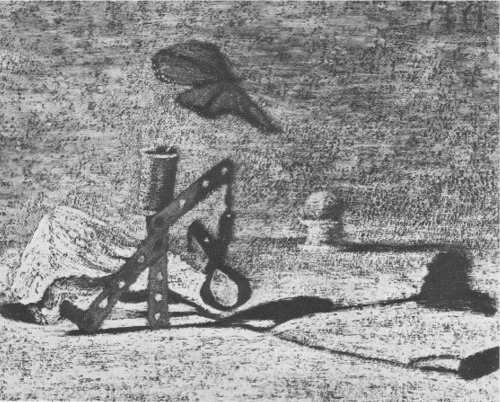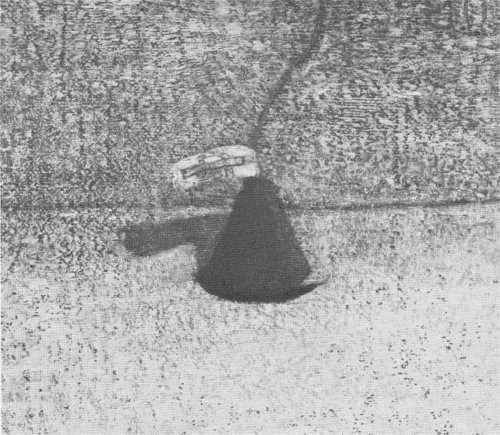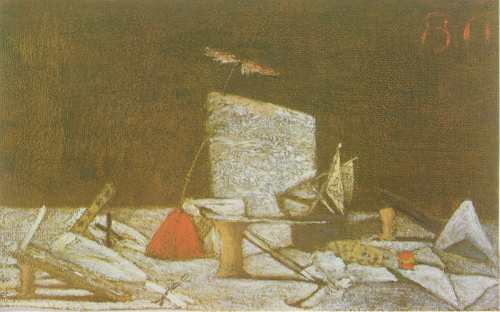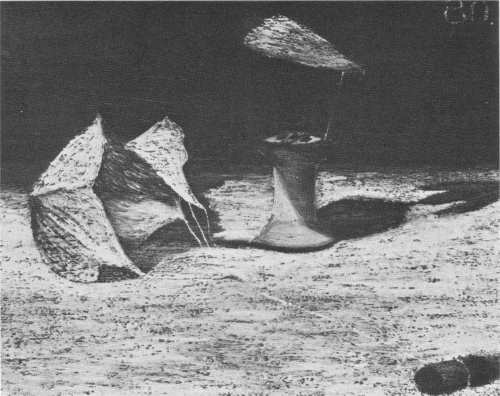Michael Shepherd
FRANCIS POUND
Michael Shepherd is a painter who for some years has sold paintings without ever exhibiting, and has over that period destroyed nearly all the works not saved by selling, or has painted over them, his dissatisfaction with them in some part mitigated by an anticipatory pleasure in the puzzling pentimenti that must, he knows, emerge in time through the numerous overglazes. Shepherd is immensely conscious of the life of paintings in time: conscious of what paintings are going to look like. He paints, as he claims the old masters did, with hidden glazes intended to emerge when the overlayers saponify - when, that is, the pigment particles that float forever in their medium shrink together to reveal what lies behind.

MICHAEL SHEPHERD
Still Life Capriccio 1980
oil on canvas,
220 mm x 270 mm
(Collection of Mrs Mcintyre,
Auckland)
In any case, at this moment in time, we owe to Shepherd's first exhibition, at the Denis Cohn Gallery in March, or, let us be exact, to those who bought the paintings hung there, the saving of those works that otherwise would have suffered the cumulative acidities of his dissatisfactions: those destructions that invariably result from his brooding too long on his own works, too much comparing them to his beloved masters, to Vermeer, say, or Seurat, or with what he might have painted, had hoped to paint.
That anticipatory touching above on Shepherd's concern with old master techniques leads to what I believe is an essential question raised by his work: might Shepherd's paintings be mistaken for old still fifes- The great age of still-lifes was the Dutch seventeenth century. Its tendency, as Barthes has categorised it, is to say: 'The world is finite, the world is full of numerable and contiguous objects . . .' The world, or rather, everything in it, is proclaimed as graspable object. Still life, that most bourgeois of genres, is also the most bourgeois of gestures, the gesture of appropriation, the appropriation of the world. But in Shepherd's still lifes, nothing is appropriated, nothing can be grasped.
What Shepherd does rather, or does when he is most himself, is to cast doubt on objects, on their shape, their size, their density, their position in space, the qualities that make up for us the very being of an object. In Shepherd's little paintings I sense an anxiety that objects can't be known, can't be caught in paint. There are only what Goethe once called 'the deeds of light': and light there gives evidence more for itself than for the objects it so arbitrarily masks, passes across, or in momentary pauses, marks and might seem to reveal.
This is not just a matter of technical competence in drawing and modelling in light and shade, though there has been a slow accession of that in his works. The gains evident from 1976 to 1980 have allowed him only to approach a more subtle expression of doubt, the doubt to dig deeper.
I have said, and will go on to show, that Shepherd's work differs from traditional still-life by its doubt of objects; and I will say too that he doubts the means of representing them. There is though, in his work, a debt, a great debt, to tradition. In his earlier works, now mostly destroyed, a close study of Morandi's work was clear - perhaps too clear. There was the same use of bottles and blocks huddled together against a melancholy void, or below the ache of a table's horizon; and the same flattening of forms to opaque, densely-textured patterns of paint. In his later works the debts are at once more diverse and more self-conscious. Actually, he has become so much more assured in his converse with old masters that one might better speak of his playing games with them than of his debts. Sometimes his titles themselves acknowledge a predecessor. The title Attributes of a Marijuana Smoker for instance, shows a conscious homage to Chardin, for Chardin painted A Smoker's Requisites, sometimes called Attributes of a Pipe Smoker. (Never, though, would Chardin have allowed so vast a void to invade his forms - his objects always hold their own.) The title Capriccio gracefully bows to Guardi's still-lifes of the same name, Shepherd's Capriccios, like Guardi's being collections of odd objects oddly conjoined. (Listen to a description of the things in one of them: there is a Meccano crane and its grab, topped by a cottonreel; from the reel a Monarch butterfly appends on a pin; there is an electrical insulator too, way off in the pearly blue, with a bottle alley marble on top.)

MICHAEL SHEPHERD
The Anzac Poppy 1980
oil on canvas,
170 mm x 200 mm
(Collection of Marlene Jensen,
Auckland)
The biggest bit of evidence for his use of past painters is the Large Dark Still Life that he is presently painting, a study for which was shown in the Denis Cohn exhibition. Shepherd intends to exhibit it later as the star work amidst a galaxy of studies. This self-consciously 'major' work borrows much of the composition of Courbet's The Studio: A Real Allegory Summarizing Seven Years of My Life as an Artist 1855 (Louvre). In a series of overpainted xeroxes Shepherd made of The Studio, still-life objects gradually supplant Courbet's figures and objects, so the whole scale of represented things is reduced. For the pyramid of seated figures the pyramid of an ANZAC poppy is substituted, for the little boy, a cotton reel -and so on. Justas Courbet's Studio summarizes his subject matter over the last seven years, so Shepherd here brings together many of the objects he has depicted in innumerable separate paintings over the last seven years. His formal debt to Courbet then, becomes part of his content. This is an essential point: I shall not return to it.
Little formal references to Seurat also abound in Shepherd's work. In Still Life with Tin Funnel 1980, for instance, in the centre foreground, an adjustment mechanism for an old motorcycle almost exactly echoes the stancheon in the centre foreground of Seurat's Le Chanel de Gravelines Petit Fort-Philippe 1890. One can see why a still-life painter might delight in what John Russell has called Seurat's 'marine furniture'; you could say that all of Seurat's magical world is stilled life. But perhaps of all these dead masters it is Vermeer that Shepherd feels closest to and makes most of.
Vermeer's work has been said to 'mark the surrender of comprehension as a pictorial function'. These words, written by Gowing of Vermeer, might just as well refer to Shepherd, or, to put it another way, Shepherd has felt for this surrender of comprehension in Vermeer.
'Light and shadow proclaim their own epigrammatic statements: they override the logic of form.' (Gowing, of Vermeer).
'He modulates without regard for the individual forms, in much the same way in which light flows.' (Goldschneider, of Vermeer)
The same might be said of Shepherd. Where light doesn't illuminate an object, as in the 1914 Rugby Cap 1980, where the stem of the large cotton reel supporting the cap is lost to the light, so the cap seems to float up in the dark, supported, impossibly, by its own golden tassels; or where light too completely illuminates, as in the white blur of the Radio Capacitor 1979 (private collection), Shepherd hardly tells us what the dark or light forms are, where their boundaries or divisions lie - the linear convention is lost.
As well as the rejection of line, Shepherd has learned from Vermeer an indifference to conventional continuity of modelling. In conventional naturalistic painting, on the other hand, each and every object is separately and continuously modelled, so that each might seem graspable. In Vermeer's painting, where there is no light or lots of light on objects, we are sometimes given only a flat colour. But the isolated accent Vermeer adds then is so marvellously assured that we take the rest of the shape on trust: whereas in Shepherd's work the accent itself seems placed in doubt, and so we are led to doubt the rest. Only in some of his later works, such as the Marble Series, does the accent of light seem sufficiently sure for us mentally to make form about it.

MICHAEL SHEPHERD
Maquette for a Large Painting
(Homage to Courbet)
oil on canvas, 140 mm x 220 mm
(Collection of Denis Cohn)
Vermeer's habits of focus too have been used to explain the inexplicability of some of his forms. From the camera obscura Vermeer derived that vagueness of the nearest portion and the mellow focus of the middle distance, rich in details: with him the light dissolves the phenomena to the point of making tangible things unrecognisable.
In the foreground of Shepherd's favourite Vermeer, The Lacemaker (Louvre), coloured threads become dribbles of coloured blur, and the objects are blurred into namelessness; or, perhaps one should say, into formlessness, since however clearly such forms were described, we could no longer name them. A significant story . . . Shepherd once told me he could doubtless identify the foreground objects of The Lacemaker by looking for them in some book of seventeenth century lacemaking - but that he preferred not to know. It's as though The Lacemaker's foreground has the poetical patina, that blurred bloom of remoteness, that the naturalistic code normally grants only to its backgrounds, and Shepherd prefers the ambiguous caress of such a patina to the raw, mundane matter that lies behind. In Shepherd's work such accidents of vision as soft focussed foregrounds aren't just, as in Vermeer, marked as empirical truths: Shepherd deliberately searches them out. He plays with the camera obscura, a technique he presumably borrows from Vermeer, out of a delight in its pure visual effects, caused by, yes, but mysteriously separated from, the object that cause them.
Unexpected things can happen in the camera obscura's light. In Study for a Large Adze 1979 (private collection), the shadow at the base of a cotton reel is bowed by the curvature of the camera lens. Everywhere there are large shadows twisted across Shepherd's depicted objects, or over the planes on which they rest: shadows sometimes with no visible origin. You could compare such shadows to those in de Chirico's 'metaphysical' works, but here they are less literal -they are not the shadowed silhouette of an unseen stranger, fearfully clear; rather, the shadow itself is the unknown stranger.
There are many odd, uncorrected ambiguities of light and shade in Shepherd's work. In Dark Large Collar 1979 (collection of the artist) for instance, the shadowed area across the foreground would seem to be the vertical plane of the table's side, and the lit part to be the horizontal plane of the table's top: but if so, the tie floats out, unsupported, into our space. The tie is a tone or so darker in the area of shadow than it is in the area of light, but it is insufficiently darkened to make us certain whether it lies partly in shadow and partly in light on the horizontal plane of the table top, or whether it stretches towards us through empty space. An old master would have corrected this ambiguity in what he 'saw' by what he 'knew', corrected it in the interests of clarity. In one of Shepherd's Capriccios 1980, the arrow-shaped shadow caused by a moth is technically indistinguishable from the weight part of a toy parachute - both seem to be cast shadows. Only seeing the weight in another of the Capriccios, where it is signified as cylindrical by a white arc that represents string, can we learn of its form.

MICHAEL SHEPHERD
Paper Parachute and Moth 1980
oil on canvas, 200 mm x 250 mm
(Collection of the artist)
In Cotton Reel & Razor Fourth Version 1978 (collection of the artist), at the meeting place of the handle of the razor and the table top, is an anchor shape. An anchor badge it was in reality, so Shepherd tells me, but here it seems like a shadow of itself. Yet if it is to be called a shadow, where then is the object that casts it- It is as fragile, as fugitive, as faint-edged as a shadow. It seems to sit nowhere in space, but to be cast flat on the plane of the table top. Nor is it possible in terms of technique to distinguish it from shadow, say the shadow cast by the razor's handle. Like all of Shepherd's shadows it is, literally, the absence of light: it is the dark glazing that underlies the white coat of impasto, revealed only in the gaps between impastoed light, or in those pits of the linen's weave that have escaped the burden of the loaded brush. (A paradox of naturalistic painting: it is its light that is most heavily painted - a paradox of which Shepherd's painting is not unaware.)
Shepherd knows that the camera obscura does not show the world as it 'really is' , or even as it ,really looks': it is the very unreality, the poetical distortion of light he delights in. His defects of drawing in the old academic sense, his inattention to the plausible reconstruction of palpable forms, are among his principal means of expression. Some of Shepherd's concerns may seem eccentric today: still life; old master materials and methods; traditional pigments: terre verte, rose madder, vermilion, lapis lazuli, siennas raw and burnt, ochres and umbers; gesso and linen grounds; scumbles, glazes, impastoes; and the old masters themselves. But, funnily enough, despite Shepherd's love and knowing of old masters' craft, his paint never looks like theirs. His impasto, for one thing, is less of a paste than a liquid, is about the liquidity say, of Dulux enamel - it's as though he is 'original' in spite of himself, aiming to copy the old masters' technique and being 'modern' where he misses. And, as in modernist art, in Shepherd's too, the world is in retreat: he is concerned, as is much modernist art and philosophy, not so much with the world, as with the ways of regarding the world. One of these ways is the camera obscura; another is the naturalistic convention of painting; and these two ways can be combined, and so combined that they comment on each other, and undermine each other.
Shepherd attempts to show something of what he has seen in the camera obscura's light: he doesn't paint what he knows to be there, in the way that the naturalistic canon demands. As an eighteenth century writer put it: 'the effect of the camera obscura is striking, but false'. Its light is like an underwater light, a mellowed and mysterious glowing, with unexpected accretions and absences. In some of Shepherd's works he has come close to its playing on things.
Things. What things? Let's make a list - a list as lists are, lovely and telling. Shepherd reproduces in paint such things as: a twist of paper; twisted Joints'; a packet of yellow zig-zag papers; matches; a waxed paper hospital cup; reels of cotton; coils of wire; clockworks; needles and threads; old fashioned detachable collars, ties or caps; razors (the cut-throat kind); false teeth; a crocodile clip; radio capacitors; carburettors (for machine lovers ... Brown & Barlow '15, Downdraught Zenith'39, Nash Hot Box '29, Updraught Carter '28); marbles - alleys, cat's eyes, ponkers, bonzers; toy parachutes, red ANZAC poppies; a 303 shell; a 'blue lady' (junkie slang-for a blue-glass syringe); and Reckitt bag blue; a 1914 football cap; butterflies; moths; military badges; Meccano; little tin flags; he used to do bottles and bowls, but flowers never; a cube, a pyramid, a sphere; spectacles; cards; handkerchiefs of silk; ribbons, a gunsight; an anchor badge; adzes of jade; man-made things, intimate, now, or once, with use.
Maori adzes now are items of archaeology, not tools. Shepherd collects and restores Maori artefacts - half his library concerns then - he haunts and is haunted by museums; and such an interest, I want to suggest, is central to his work. All the objects of his still lifes are items of archaeology now, or will be: by all of them men's lives may be imagined, or, as by an archaeologist, plausibly reconstructed. It is significant that most of his objects are sufficiently old to be no longer in use: the cotton reels are wooden, not plastic: the 'tractor', made with a wooden cotton reel notched with a knife, and a slice of candle and a rubber band, was a popular toy twenty to thirty years ago, when people still made their own toys; the bike parts are of the 'twenties and 'thirties; the matchboxes of the old Beehive kind before it was boringly Bauhaused; the zig-zag packet has been unchanged for thirty years. The objects are old, but not old enough to have the glamour of the antique; nor yet of the recently refashionable Art Deco kind; nor of the 'fifties, sentimentalised by the so-called New Wave; rather, they are of the kind you might find in your parents' house if you were twenty-five to thirty-five years old, and your parents were hoarders.
Many of Shepherd's subjects, I suspect, are found in old drawers in his parents' house, unopened for thirty years, but opened by him and furtively sketched, or their contents rifled, painted, and put back, unknown to their owners. For his objects have old memories clinging to them still, like a fine and pervasive dust. Shepherd once said to me that if he exhibited, he would like to do it under a false name, because his parents would be furious if they saw his work.
presume this curious remark refer to some kind of invasion of privacy. Even the size of most of Shepherd's work (say six by nine inches) and the way it was exhibited, or rather, not exhibited, in his final showing at art school - hidden away in a box, in an empty room, instead of being revealed on the walls - is redolent of a desire for privacy, of intimacy, of an unwillingness or an inabiIity to reveal.
I have suggested that the subjects of Shepherd's still lifes are not accidental, his concern for them not merely formal. And yet, of all the genres of figurative painting, still-life has been called the most subjectless. It was once regarded as the lowest of the genres, because it told no stories. And just because it did sidestep the traditional requirement of paintings that they tell stories, it has often been regarded as the painters' painters' genre, the most purely formal of them all. When Picasso and Braque for instance, set out to revolutionise pictorial form, it was largely still-life they chose to do it with - it left them, you see, free for purely formal concerns. One might imagine an abstract painter saying, in accord with modernist dogma, that any figurative painting today is automatically retrogressive. But still, at least, he might say, still-life is the least displeasing. Shepherd, I know, is troubled by such accusations, real or imagined, troubled by the absurdities of figurative painting today. And vet, I want to suggest, Shepherd has made of such doubts part of the form and content of his painting.
Such conventions, for instance, as painting the date of the painting into the painting, or the convention of the frame, are subjected by him to an occasional scrutiny. In the Study for the Large Dark Still Life, 1980, exhibited at the Denis Cohn Gallery, the three brightest notes are three sharp vermilions -one is a radio capacitor, one is a poppy, the other is the figure '80'. Since the date is an evidently flat inscription, a sign on a flat surface, and is painted in a way that makes it as important an element of the painting as any other, so, by implication, the rest of the painting too is but inscriptions, signs on a flat surface. In Still Life with Toy Parachute& Grabs 1980, the vermilion '80' is modified by yellow where it overlaps the green bit of Meccano, as if the numerals are as much of a thing, or not a thing, as the other things in the painting. Again, levels of unreality are suggested. Sometimes the numeral added to the painting, that is, the date of the painting, is playfully compared with the date of the thing painted, as in 1914 Rugby Cap, 1980, where the bright '80' and the '1914' are granted equal importance. In Still Life with Red Border, 1980, the border blatantly acknowledges it is just flat, unmodulated paint on canvas, and yet across it a piece of Meccano obtrudes itself and its shadow. The picture plane might seem punctured there, but paradoxically punctured only through its most flat part - its border. We are first led to doubt this piece of 'illusion', and so to doubt the rest.
Finally: I may have misread, or read too much into, Shepherd's hesitancies. Could it be that I am like that man of Borges who claimed to have rewritten, word for word, exactly and without copying, the whole of Cervantes' Don Quixote, and of whom Borges showed with examples (attempted brilliantly to show) that each of his sentences, though in no way differing from Cervantes' now meant something quite new something essentially modern- I am returning to the question I asked as the first sentence of the second paragraph of this review, the question I have regarded as an essential one raised by his work: might Shepherd's works be mistaken for old still lifes? I have answered, no: but there is always the danger with questions about a painter just beginning to find himself in his work that you will ask the wrong things, answer a question wrongly, one that will clearly be answered in his later works.
